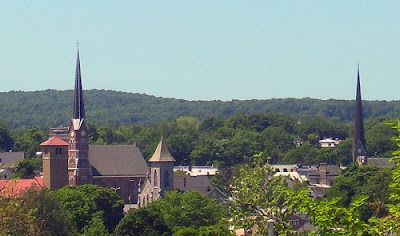The Chesapeake and Delaware Canal and New Castle County
Architecture
The
Delaware City Historic District is
significant for its architecture, for its beginnings as a planned settlement,
and for its importance as a nineteenth century canal-oriented transportation
center. The buildings within the district date from 1826, the year the town was
laid out, displaying significant development through 1930. The town was
envisioned by its backers as a place that would develop into a major shipping
and trading point for traffic that passed along this trans-peninsular trade
route, and so, its early plans were based on the completion of the Chesapeake
and Delaware Canal.
Delaware
City is located 14 miles south of Wilmington,
the largest city in Delaware, and 40 miles south of Philadelphia, Pennsylvania.
The built area of town is roughly bounded by the Delaware City Branch of the
Chesapeake and Delaware Canal on the east, the Delaware River on the north,
Dragon Creek on the west, and Delaware Route 9 on the south.
Located within the limits of an incorporated town of approximately 1,800
people that is situated in the eastern central area of New Castle County,
Delaware, the town is strategically located at the eastern terminus of the
Chesapeake and Delaware Canal where it joins the Delaware River.
The 68-acre district is made up of 252 sites that include 232 major
buildings
East of the
canal branch, but outside the boundaries of the
district, is Polktown, a small community that was settled by free Blacks in the
1830's, and the Fort duPont site, established in 1863 as an auxiliary gun
battery, later used as the headquarters for the Delaware River and Bay Defenses
during WWI and WWII.
An important feature of the economy of
Delaware City is the expanse of marshland bordering parts of the canal, the river,
and the creek that harbored substantial game bird and muskrat populations. Much
of the outlying area beyond the marsh was highly productive agricultural land
during the nineteenth century and is still so used.
Three
related National Register sites are located
just outside the district:
1. Eastern Lock of the Chesapeake and Delaware
Canal
2. Fort Delaware, a Civil War Prison located on
an island in the Delaware River.
3. Chelsea, an 1848 brick, Greek Revival style
dwelling built for Thomas Jefferson Clark, member of one of the leading
families in the area.
Architecture
Delaware
City's main emphasis is on buildings of the
mid-to-late nineteenth century, its greatest period of growth. Several of the
earliest buildings in town are brick Federal style dwellings. The accepted plan
was a two-story, gable-roofed, double dwelling with a symmetrical four-bay
facade and fanlights above the entrances.
The most
prominent house type of the
mid-nineteenth century is the Greek Revival style. Based strictly on the two or
two-and-a-half story, flat-roofed, square plan, there are no temple front or
cross wing versions of this style in Delaware City or in its environs.
 The
Italianate style did not bring
about much of a change in Delaware City's architecture since it was based on
the same flat-roofed, square plan as the Greek Revival style. Because of the
subtle difference between the Greek Revival and Italianate styles, features
from both styles were sometimes combined, creating a transition between the
two. The Queen Anne and Bungalow styles became prevalent in the twentieth
century.
The
Italianate style did not bring
about much of a change in Delaware City's architecture since it was based on
the same flat-roofed, square plan as the Greek Revival style. Because of the
subtle difference between the Greek Revival and Italianate styles, features
from both styles were sometimes combined, creating a transition between the
two. The Queen Anne and Bungalow styles became prevalent in the twentieth
century.



















